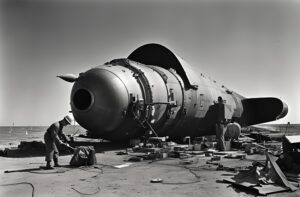
The year was 2045 and a significant change had occurred in the global political landscape. Human history had made an unprecedented leap – a worldwide ban on nuclear weapons was successfully enforced. The Global Disarmament Accord (GDA), a landmark treaty, was the result of long-standing diplomatic efforts, innovative technological advancements, and universal desire for a more secure, peaceful world. As every last signature dried off, a collective sigh of relief resonated globally. Leaders and citizens alike allowed themselves to hope that humanity had at last renounced its most destructive weapon.
The inaugural months of the ban were marked by grand celebrations, with cities hosting parades and landmarks beaming with peace messages. It appeared humanity had made a significant stride out of the nuclear annihilation shadow. Countries, once adversaries, began to foster new alliances. An era of goodwill and cooperation was ushered in, bringing a renaissance in international relations. There was a collaborative surge in scientific research, with erstwhile competitors now joining hands to address global challenges such as climate change and disease. Funds previously meant for maintaining and upgrading nuclear arsenals were redirected towards education, healthcare, and sustainable development.

However, the disarmament era did present challenges. The process of dismantling nuclear arsenals and maintaining transparency needed tremendous logistical coordination. Sensitive materials had to be meticulously disposed of, and innovative technologies were invented to prevent any clandestine rebuilding of stockpiles. The International Disarmament Commission (IDC), the governing body with the daunting task of overseeing this enormous effort, operated with exceptional authority and transparency. Its power included conducting surprise inspections, with investigation results going public in real-time. Some nations initially resisted this high level of oversight, but the collective memory of nuclear nightmares kept any opposition in check.
As this new reality sank in, the world began to adapt. The elimination of the nuclear war threat led to unpredictable shifts in geopolitical dynamics. Power balance now rested not on who possessed the most destructive arsenal, but who could form the most effective alliances and display the greatest diplomatic skill. Regional conflicts still brewed but were resolved through negotiation and conventional methods, removing the risk of nuclear escalation. The United Nations underwent a transformation, evolving from a perceived ineffective body into a hotspot for conflict resolution and international law enforcement.
Technological innovation thrived in this new world order. Scientists and engineers, liberated from the grip of mutually assured destruction, focused their skills on tackling humanity’s pressing issues. Renewable energy solutions like solar, wind, and fusion made significant advancements, rendering fossil fuels obsolete and substantially reducing carbon emissions. Artificial intelligence and robotics evolved at an unprecedented rate, revolutionizing various industries, from agriculture to medicine. Space exploration became a worldwide venture. International space agencies collaborated in establishing the first permanent human settlements on the Moon and Mars. Humanity began to coalesce around a shared vision of progress, free from the fear that had divided it.
However, the journey wasn’t an entirely smooth one. The wealth gap between affluent and poorer nations initially widened since countries with more resources more swiftly adapted to the post-nuclear world. To address this issue, the Human Advancement Fund (HAF) was created. Wealthier nations donated a substantial part of their GDP to aid in the development of infrastructure, education, and healthcare in less developed nations. The objective was to create a more balanced world, with opportunities for everyone to flourish. Despite initial mixed results, the effort yielded significant progress with consistent commitment.
Socially, the nuclear weapons ban had a profound impact on global psyche. The collective decision to abandon mass destruction weapons fostered a sense of global unity. Cultural exchanges saw an uptick, and individuals worldwide connected in ways previously deemed impossible. Artists, musicians, and writers found new inspiration in this era of collaboration and hope. Themes of unity and peace began to permeate popular culture, mirroring and reinforcing the global sentiment.
Nevertheless, the abolition of nuclear weapons did not eradicate all conflict forms. Traditional rivalries resurfaced, and new power struggles emerged, with some nations using economic means or cyber capabilities to vie for dominance. The IDC had to constantly recalibrate to ensure compliance, and tensions sometimes arose when nations accused one another of treaty circumvention. Despite these hurdles, the overarching trend remained positive, as the advantages of a nuclear-free world proved to be immense.




